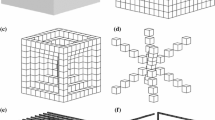Abstract
A method is described for representing voxel-based objects by means of enclosing trees. An enclosing tree is a tree which totally covers a voxel-based object, the vertices of the enclosing tree correspond to the vertices of the enclosing surface of the analyzed voxel-based object. An enclosing tree is represented by a chain of base-five digit strings suitably combined by means of parentheses. The enclosing-tree notation is invariant under rotation and translation. Furthermore, using this notation it is possible to obtain the mirror image of any voxel-based object with ease. The enclosing-tree notation preserves the shape of voxel-based objects, allowing us to know some of their topological and geometrical properties. Also, the proposed enclosing-tree notation is a good tool for storing of voxel-based objects.




















Similar content being viewed by others
References
Bribiesca E (2008) A method for representing 3D tree objects using chain coding. J Vis Commun Image Represent 19:184–198
Bondy JA, Murty USR (1976) Graph theory with applications. MacMillan Press, London
Ballard DH, Brown CM (1982) Computer vision. Prentice-Hall, Englewood Cliffs
Duda RO, Hart PE (1973) Pattern classification and scene analysis. Wiley, New York
Gonzalez RC, Woods RE (2002) Digital image processing, 2nd edn. Prentice Hall, Upper Saddle River
Karush W (1989) Webster’s new world dictionary of mathematics. Webster’s New World, Simon & Schuster, Inc., New York
Guzmán A (1987) Canonical shape description for 3-d stick bodies. MCC Technical Report Number: ACA-254-87, Austin. http://www.divshare.com/download/6279793-67e
Bribiesca E, Velarde C (2001) A formal language approach for a 3D curve representation. Comput Math Appl 42:1571–1584
Cayley A (1889) A theorem on trees. Quart J Math 23:376–378
Sagols F (1999) Hamiltonian representation of vox-solids. Computación y Sistemas 4:213–217
Kikuchi L, Guevara JA, Mark D, Marble DF (1982) Rapid display of digital elevation models in a mini-computer environment. In: Proceedings of ISPRS Commission IV, environmental assessment and resource management, Crystal City, Virginia, USA, pp 297–307
Voelcker HB, Requicha AAG (1977) Geometric modeling of mechanical parts and processes. Computer 10:48–57
Boyse JW (1979) Data structure for a solid modeller. NSF workshop on the representation of three-dimensional objects, University of Pennsylvania
Soroka BI (1979) Generalised cylinders from parallel slices. In: Proc., PRIP, pp 421–426
Soroka BI, Bajcsy RK (1976) Generalized cylinders from serial sections. In: Proc., 3rd IJCPR, pp 734–735
Brooks R (1983) Model-based 3-D interpretations of 2-D images. IEEE Trans Pattern Anal Mach Intell 5:140–150
Requicha AAG (1980) Representations for rigid solids: theory, methods, and systems. Comput Surv 12:437–464
Besl P, Jain R (1985) Three-dimensional object recognition. ACM Comput Surv 17:75–145
Pentland A (1986) Perceptual organization and the representation of natural form. Artif Intell 28:293–331
Bribiesca E, Guzmán A (1980) How to describe pure forms and how to measure differences in shapes using shape numbers. Pattern Recogn 12:101–112
Galvez J M, Canton M (1993) Normalization and shape recognition of three-dimensional objects by 3D moments. Pattern Recogn 26:667–681
Bullow H, Dooley L, Wermser D (2000) Application of principal axes for registration of NMR image sequences. Pattern Recogn Lett 21:329–336
Acknowledgments
This work was supported by IIMAS-UNAM and by SNI-CONACyT. LAM acknowledges to PASPA-UNAM program. DEM data used in this study were provided by INEGI.
Author information
Authors and Affiliations
Corresponding author
Rights and permissions
About this article
Cite this article
Bribiesca, E., Guzmán, A. & Martínez, L.A. Enclosing trees. Pattern Anal Applic 15, 1–17 (2012). https://doi.org/10.1007/s10044-011-0240-z
Received:
Accepted:
Published:
Issue Date:
DOI: https://doi.org/10.1007/s10044-011-0240-z




